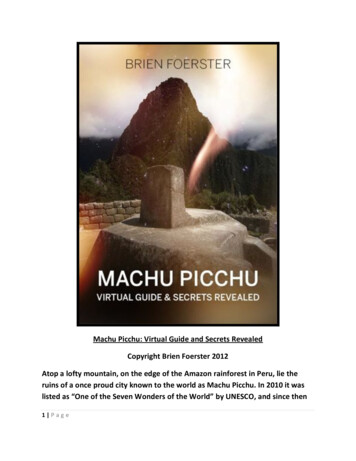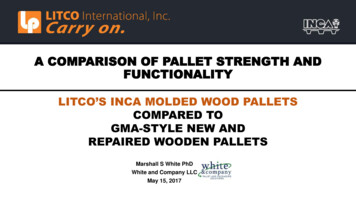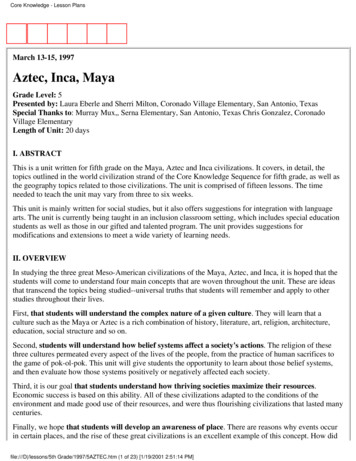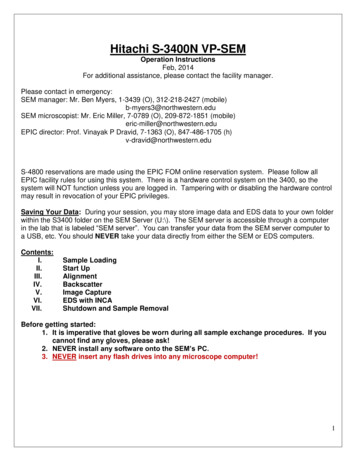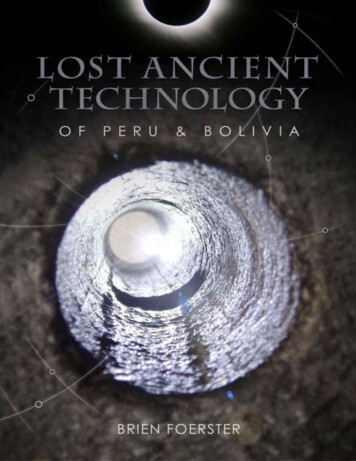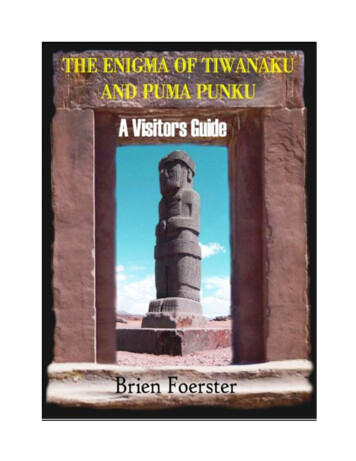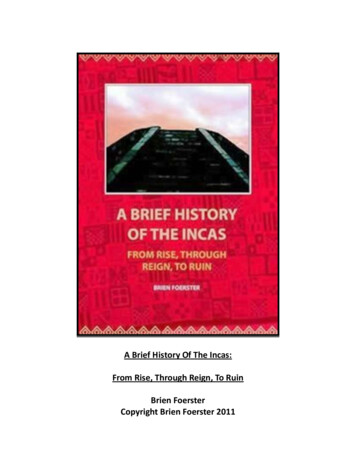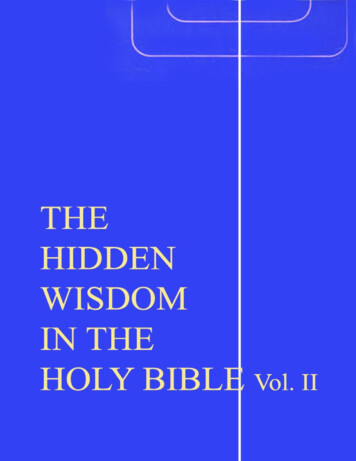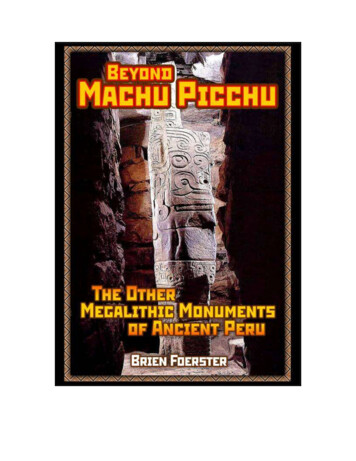
Transcription
Beyond Machu Picchu:Other Intriguing Monuments Of Ancient PeruCopyright Brien Foerster 2011DedicationMy thanks to the ancestors of all of the great cultures of Peru, well known, andlesser known, for at least leaving behind for us traces of their glory. Many people,Peruvians included, seem to think that the Inca were the only great civilization ofpre-Hispanic Peru, and with this book I hope to shed light on the other greatpeoples who populated this land. To my own ancestors I give thanks, as well asmy father and mother who encouraged me along this road of inquiry, education,and respect for cultures other than my own. And to my dearest Irene, whoseheart beats with the souls of those who came before her in this great land, andfor the glow on her face when she shares with me the wonders of ancient Peru.Chapters1/ Introduction2/ Before You Leave3/ Passport4/ Plane Ticket5/ Money6/ Medical Help7/ What Clothes To Bring?8/ Sun Block
9/ Leaving The Airport10/ Where To Stay And What To Do In Lima11/ Pachacamac: Lord Of The Earthquake12/ Caral13/ Chavin De Huantar14/ Chan Chan And The Pyramids15/ Moche Temples Of The Sun And Moon16/ Cumbemayo17/ Otuzco18/ Kuelap19/ Sipan20/ Pyramids Of Tucume21/ Paracas22/ Ica23/ Nazca24/ Sayhuite25/ Choquequirao26/ Sillustani27/ Amaru Muru1/ Introduction
Before we get into the adventure that his pre-Spanish Peru, I wish to offer youthese tips that will make your arrival comfortable, your journey safe, and yourwhole experience one of ease and delight. Most people from abroad only visitPeru once; usually this is because it is a long and expensive journey by plane fromEurope, North America, or Australia. In order to maximize the time andexperience for these mainly these travelers, I have decided to write this book.Having visited Peru multiple times, and now living here, I think I am experiencedenough to give enough helpful suggestions to make your visit to this country, andperhaps a side trip to Bolivia, the best it can be. I have written this in a style whichis basically a timeline; from getting on the plane, to arrival, through the visit, andthen departure. The majority of what I will speak about pertains to the history ofthe country, as in the Inca, etc, so this is not really a “holiday” guide as such.When one thinks of Peruvian history, especially pre-Spanish occupation, whichbegan when Francisco Pizarro and his “conquistadors” arrived in 1532, the Incaspring to mind. However, though the Inca were a mighty and highly evolvedculture which played a huge role in the history of Peru from about 1200 AD untiltheir demise at the hands of the Spanish, there are many other cultures which arealmost as fascinating. From the Tiwanaku, or Tiahuanaco, who lived just overwhat is now the southern border close to Lake Titicaca, through the Chimu,Moche, Paracas and Chachapoyas, one could easily spend a month in Peruexploring historical wealth that goes back thousands upon thousands of years.This book acts as a cursory guide to the cultures that left a living legacy throughwhich we have a window into the past 2/ Before You LeavePlease don’t get paranoid, just be precautious. The obvious things to prepare for atrip to Peru, or in fact any country that you are not acquainted with, are:passport, plane ticket, money and medical. Peru has been called a “developingcountry” etc., but it is in no way primitive. However, the farther you go from thekey centers, mainly Lima, and Cuzco, the more “rustic” everything becomes. Somebasic planning on your part will make sure that you not only have a pleasurable
and educational experience, but that you will probably leave wanting to comeback.3/ PassportVery few, if any citizens of major countries need to get a visa to enter Peru; tomake sure that this is the case with you, check your government’s web sites, orhttp://www.expatperu.com/vrequirements.php, which is an excellent resource. Ingeneral, travelers can visit Peru for up to 183 days, and the visa is provided onceyou enter customs and immigration at Lima International Airport. TheIMPORTANT thing to state to the customs official is how long you plan to stay inthe country. If you say “about 3 weeks” then they will give you, probably, exactly21 days. So, when in doubt, overshoot your estimated visiting time by at leasttwice that which you are considering.The reason for this is that extensions to visits are no longer available inside Peru;if you originally planned to say, again as an example 3 weeks, and decide to satyanother week, you have to leave the country in order to get an extension. Asidefrom being inconvenient, this can also be time consuming and expensive, becauseyou will either have to fly out of the country, to Bolivia, Brazil, or Ecuador forexample, to one of the major border towns, such as Piura in the north to Tacna inthe south, or take a VERY long bus ride to one of these places.The visa I refer to is solely a tourist visa, if you plan or are considering working inany capacity in Peru, this is a very complex and somewhat expensive matter, asregards paperwork and government permission, and should be dealt with via yourembassy.4/ Plane TicketThis may sound obvious, but do make sure that you have either a return planeticket from your home country, country of embarkation, or have one which will flyyou on to another country before your tourist visa expires. Some people havesuccessfully entered Peru, via the Lima International Airport with a one-wayticket, however, the customs officer does have the right, by law, to ask to see
your on going ticket, and if you refuse to provide it or don’t have one, you can beimmediately be deported, at your own expense.Not only would this be an expensive mistake on your part, but it could result infuture travel restrictions or even a ban on your future visits to the country. Also,be aware that the vast majority of the customs officials speak little if any English,and certainly will not have any knowledge of other languages. This is aphenomenon that travels face in this country in general, only about 5 percent ofthe general population speaks any foreign language in Peru, and English is ofcourse the most popular. If you stay in 5 star accommodations in Lima or Cuzco,you will of course find staff that speak English, and probably quite well; the sameis true of major tour companies in Lima and Cuzco. However outside of these twocentral locations, don’t count on any assistance except in Spanish, and morespecifically Castellan Spanish.5/ MoneyCarry cash? Sure, why not? The American dollar is by far the favoured foreigncurrency to use for exchanging into the Peruvian currency, the Nuevo Sol (newsun.) Now of course you don’t want to carry a lot of cash with you as you walk thestreets, but securely kept in a hip wallet, not worn on your person is a good idea.Travelers checks are another option, but have to be cashed at a bank; you willhave to have your passport and possibly even other ID as well with you, and thatis a hassle. They are quite a safe option, but again, they are a hassle. There are ofcourse bank machines, where international debit and credit cards work. These arelocated in all of the major banks, as well as at the airports, some bus terminals,and major shopping centers. The ones which are at the banks are of course themost secure, such BCP, BIF, ScotiaBank and InterBank, whereas the privatelyowned ones can be suspicious as to security.In general, I recommend that at least 25 percent of the money you bring shouldbe in the form of cash, and only US dollars, or Euro; other currencies may beaccepted, but are a hassle. The Canadian dollar, for instance, though it is worthmore than the US one at the present time, is rarely accepted, and when it is, at a
reduced rate of 70 to 80 percent what a US dollar brings. And don’t buy NuevoSols outside of Peru; you will not get a good exchange rate, especially atInternational Airport currency trade booths, which are often a rip off.Money can also be traded on the street; the people who do this are usuallylocated outside of banks and airports, but be weary, they can offer youcounterfeit bills. What, you say, fake money? You bet, Peru is one of the largestproducers of counterfeit US dollars and Nuevo Sols in the world, and some arevery close to being perfect copies. However, every shop owner and hotel staffmember in Peru knows how to spot a fake bill for the real thing, so do the smartthing, change money at a bank.How much to carry? That is always a good question; the basic policy is, bring withyou about the amount of money that you think you will use in one day. This maymean 25 for some, and 100 for others; it depends on what you are doing, andyour expectations as regards food, etc. Crime is not what some people say it is inPeru; most people who say that it is a dangerous country for travelers are peoplewho have never been there, or “I heard someone say” sorts of folks. Ignore them;they have no clue of what they are talking about. Peru is in general quite safe, thegovernment is stable, and a legacy of Christianity, though it has had somenegative results, has instilled in most Peruvians a strong adherence to the “10commandments.”Exceptions to the above are some (many) neighbourhoods in Lima, and late atnight in any town, in general. Police presence, especially in the tourist areas ofLima, which are very clean and upscale, and the entire city of Cuzco is easy toobserve; much of Peru’s economy is tourism, and so the government wants tomake sure that travelers are, as much as possible, protected from the occasionallocal idiot that wants something for nothing.Most hotels, especially 3 stars and up, have safes located in each room, or youcan leave your valuables with the front desk. Make use of the “safe” option morethan the front desk is my advice; and if you choose to stay in a very cheap hotel orhostel, away from the main center of Lima or Cuzco, then you are on your own,and could fall prey to a sad situation pay the extra money if at all possible.
6/ Medical HelpBring international travel insurance; that is a given. For the relatively low cost ofcoverage, from a fall, heat stroke, dog bite or even heart attack; the price you paywill give you peace of mind, and in general, a good policy will be a few dollars aday. The problem is; how do you get compensated for what may be an up front;out of pocket expense. To answer this, ask the travel agent or insurance brokerthat you get your policy from.Medical care, in general, is both inexpensive and relatively good in Peru. Worldclass? If you want to pay for the best yes, but I am referring to the averageperson, who, say for example, gets a cut or suffers from sunburn or an upsetstomach. Any parent is proud of their son or daughter should they decide tochoose medicine as a career, or for that matter become a dentist or lawyer aswell. As such, there are many doctors in Peru, and visiting them is surprisinglyinexpensive. I can ‘t quote actual fees here, but let us say that general practitionercan be visiting for about 20 dollars per visit, and specialists are about the same.The larger cities, especially Cuzco and for sure Lima, also have large hospitals andclinics which are at least partially funded by foreign governments and or nongovernmental organizations (NGO.) In general, foreigners can access the servicesprovided by these institutions, and often for the same cost that Peruvians pay.And the pharmacies are absolutely great! The two most common names they goby are Botica and Farmacia, and you will usually find one on each block, especiallyin Cuzco and Lima, as well as most other cities in Peru. Here you basically get anymedication you can think of, from cold remedies, to antibiotics, etc. Each shophas at least one pharmacist, who will prescribe for you based on the symptomsyou state! No doctor needed, nor a prescription. I actually witnessed a youngPeruvian girl asking for pain reliever for a cold she had, and then asked, by thepharmacist if she thought she had an infection as well, she said yes, and was alsosold antibiotics!Not, of course, that it is a wise thing to simply buy whatever you think will curewhat ails you, but it is awfully convenient to have the option. One of the most
important pills you can take if visiting Cuzco and Machu Picchu is a locallyavailable pill called Sorochin; excellent for preventing and relieving “Soroche,”which is the Peruvian name for high altitude sickness. Almost everyone suffersfrom this to some degree, because the most common way to get to Cuzco andMachu Picchu is by plane; in doing so, you travel from sea level at Lima to about12,000 feet in altitude in the time of 1.5 hours or less. It normally takes at least 24hours for the body to adapt to this, no matter how many vitamin supplements orcardio vascular exercise you have done to prepare for it prior to your arrival; butmore on this later.7/ What Clothes To Bring?In a word; “layers.” Peru is a relatively small country, at least compared toCanada, where I grew up, but it does contain every climatic zone in the world,from arctic (Andes) through to desert (mainly along the coast), tropical jungle (theAmazon) and even areas that look like Switzerland and California! Most visitorstend to see Lima for a short time, and spend the bulk of their time in Cuzco. Limahas a climate similar to Los Angeles, t-shirt weather in the summer, and sweaterweather in the winter. Rainfall is so minor in Lima and along the coast of Peru ingeneral, that a waterproof jacket is not required. Don’t forget that you will be inthe southern hemisphere, so the seasons are the opposite of North America andEurope.Cuzco, on the other hand, being at 12,000 feet in altitude, can display all fourseasons in one day; in the winter at least; hence, layers are the best option.Clothing, especially sweaters made from Alpaca are readily in Cuzco especially, aswell as great Alpaca socks; and deals can be had. Also, a rain jacket is a smartidea, especially one that “breathes.” Day time temperatures in Cuzco tend toaverage 18 to 23 C. and sun is the norm, however, the months of Decemberthrough February are described as the “wet season” and it can, on occasion, rainall day.Cuzco is also, don’t forget, in the highlands of Peru, as in just below the greatAndes mountains, and so the terrain tends to be quite hilly. The city itself is akin
to San Francisco, some areas are flat, especially around the central square, calledthe Plaza de Armas, while others are inclined. Nothing too difficult though.Comfortable shoes are a must, as in running shoes or hiking ones; high heals willnot work here, especially on the cobble stone streets!8/ Sun BlockIn a word, yes. Lima is about 10 degrees below the equator, and when the sunshines, it can be at least mildly intense; Cuzco, being at around the same latitudeand 12,000 feet elevation, has very little ozone protection, and even dark skinmay burn if it is not protected. Major name sun blocks are available in Lima andCuzco, but you do pay the same price as you would if you bought it in NorthAmerica or Europe; why this is I can’t figure out. Maybe because most Peruviansdon’t have light skin and therefore don’t use it?9/ Leaving The AirportThe Lima Airport, officially called Jorge Chavez International, after a famousPeruvian aviator who was supposedly the first person to fly over the Alps inEurope successfully, is rapidly becoming the hub airport for all of South America.It is very modern, and the services that it offers are of international quality.If you are being picked up at the airport by a friend or associate, that is great. Theairport, like many airports around the world, is not in the nicest part of the city; infact, it is in another city, called Callao, which is the industrial area of Lima. This isalso where the major seaport is located, and is, shall we say a “working class”neighbourhood.”10/ Where To Stay And What To Do In Lima(For The Visitor Interested In History)The only good and safe hotels in the whole Lima/Callao area are in the Mirafloresneighbourhood of Lima. This is about a 40 minute to 1 hour taxi trip from theairport. It is possible to take buses from outside the airport itself, but I strongly
advise against it. If you speak no Spanish, or even some, this area is not safe. Youcould easily get lost, and run into trouble in more ways than one.A taxi is by far the best way to get to Miraflores. You may have actually booked ahotel room in central Lima via the internet, and that is ok and reasonably safe, butMiraflores is by far the best option. The climate and surroundings are kind of across between Los Angeles and Miami, minus huge high rises, and does have avery contemporary feel. Located a few blocks from sea cliffs, it is a good area tostay, and stroll about and shop, mainly in the day, but is also quite safe at night.The taxi drivers will, plain and simply, attempt to rip you off financially, and this isthe case throughout Peru; when they see a foreign face, they automaticallyassume that you are rich. Clearly, Peruvians watch too much American television,and think that shows like “Dallas” and “Dynasty” are real.As such, they will probably say that a cab ride to Miraflores is 25 or 30 dollars. Ifyou feel like throwing money away, or are too tired to barter, go with it. However,the real price, charged to Peruvians is more like about 10 to 12 dollars. I stronglysuggest that you act as though you expect local prices, in a gentle enough way.Even if the driver only agrees to go down to 15; you have saved money. And doinsist that you are dropped off at the door of your hotel, or at least in the brightlylit Parque Kennedy. Believe me, again, the bus system is NOT a good option.Those visitors who want to taste Peruvian specialties such as Ceviche, which is adelicious raw fish dish flavoured with lime juice, peppers, and raw onions, can findthe best examples here. Seafood is amazingly delicious and varied in Peru,especially on the coast, where the cold Humboldt Current from Antarctica drawsup nutrients from the lower depths of the ocean and results in one of the mostproductive marine environments in the world. The same seafood dishes are alsoavailable in Cuzco, but since the fish has to be trucked or flown inland from thecoast, it isn’t as fresh. McDonalds anyone? Yes, that as well as Burger King andmost of the other American franchise fast food outlets are here too, for better orworse; your choice.The cost of accommodation of course varies a lot here. There are “backpacker”type places around Parque Kennedy (yes, named after JFL) as well as everything
else up to 5 star hotel; this is where the internet can help you find some optionsthat fit your budget.So how long to spend in Lima, and what to do while you are there? Most peoplestay less than 24 hours in Lima and its environs, eager to race to Cuzco and MachuPicchu. But Lima does have a lot to offer, and is good for at least 2 full days ofexploring. For example, as has been hinted at earlier, the Miraflores area,centered at Plaza Kennedy, is great for shopping, dining, and staying. There isquite a huge Native art and craft market, composed of 100s of individual storeswhich are clustered together. It is called the Mercado Indio, and simply ask atyour hotel front desk where it is.Mercado Indio in MirafloresStick with the listed prices? No everything in Peru, aside from restaurant food(though you can try by asking for the “menu” which is the Peruvian’s budget mealoption) and hotel rooms (again, you can try) is negotiable, especially when itcomes to buying clothes and souvenirs. As a general rule, the prices in the
Mercado Indio are at least 20 percent higher than what you can wind up paying,and I mean at least; if the merchant says “10” you should respond with “5,” theywill then probably say “8” and then you say “7.” The final deal will probably bestruck at “7.”If you wait until you get to Cuzco, even better deals can be had; the rents inMiraflores are the highest in the country, hence the prices are also high. There arealso some large museums in Lima, but in many cases the buildings in which thesecollections are held are more interesting and informative than the collectionsinside! The National Museum is especially true in this way; a massive concretearchitectural masterpiece, but very little of historic interest on display.National Museum of Peru
The Museum of Archaeology, Anthropology and History of Peru is a somewhatdifferent matter; it is the largest and oldest state museum in Peru, located onPlaza Bolívar in the Pueblo Libre district of Lima. It is perhaps the most visitedmuseum in Lima, located at the heart of Pueblo Libre. This museum is known forhaving one of the best pre-Columbian exhibits in the world. It offers incredibleParacas textiles and a huge selection of pottery. For directions, ask at the frontdesk of your hotel; it is best to take a taxi there and back, about a 15 minute tripeach way, as the bus system in Lima is cheap, but very confusing.The grounds of the Museum of Archaeology, Anthropology and HistoryAs far as I am concerned, the best museum in the whole area is the Larco; aprivate establishment, but reasonably priced entrance. It is located again about10 to 15 minutes by taxi from Miraflores, and definitely worth a visit if you likebeautiful ceramics.
The beautiful entrance to the Larco MuseumThe Larco was founded by the Larco Hoyle family in 1926, on the grounds of theirLima estate. It now occupies practically the entire property and is a oasis of quiet,calm, and architectural beauty in the relative chaos of Lima, a city of 10,000,000people.
The grounds of the LarcoToday, it houses the finest collection of pre-Colombian ceramic and gold objectsin all of Peru; the amazing collection of Moche culture clay works being greaterthan 275,000 pieces on display! And the gold and silver masterpieces are trulyamazing; contrary to popular belief, the Inca were not master gold and silversmiths, at least not as great as the Moche and Chimu people from the north ofPeru. It is quite probable that once the Inca absorbed these cultures into the Incaconfederation, called the Tahuantinsuyu (Four Corners Of The World) they werehired to make great works for them.
A small portion of the Larco ceramic collectionThe Larco Museum or Museo Arqueológico Rafael Larco Herrera is located at: Av.Bolivar 1515, Pueblo Libre. Lima 21, Perú. They can be contacted at: Telephone(00511) 4611312 - (0511) 4611835 or Fax (00511) 4615640.The best one day tour of the best that Lima has to offer is a bus tour that starts atParque Kennedy and takes you to through the neighbourhoods of Miraflores andSan Isidro through to the center of historic colonial Lima. This is where thecathedral, government palace, and other beautiful “old world” buildings arelocated, within a block or two of one another, all close to the Plaza de Armas, orcentral square.
Plaza de Armas in LimaThe bus service I recommend is called Mirabus, which I have taken, and broughtvisitors on. In the case of the your we took, which included both the Mirafloresand colonial Lima areas, it also took us to the Larco museum. Mirabus also offersnight time tours, and other ones of the area.The other area of Lima which is good to visit and is close to Miraflores is Barranco;which was the wealthy neighbourhood of the capital city prior to the existence ofMiraflores. Much of the latter is, or at least has the look of being 20th century inappearance; there are areas which have beautiful houses of “art deco” styledesign, harking back to the 1920s and 1930s, up to very flashy steel and glassoffice towers. Barranco, on the other hand, is distinctly 18th and 19th century.
The famous Puente de Los Suspiros (Bridge Of Sighs)It is about a 5 to 10 minute trip by taxi from Miraflores to Barranco; and though Ican’t quote an exact figure, in Soles, as to the cost, use this basic rule of thumb,here, and anywhere you travel in Peru by taxi; pay about 60 percent of the firstquote that the taxi driver states. For example, if he (or the occasional she) saysthat Miraflores to Barranco is 10 Soles, insist on 6. If he says no, wait 30 secondsor less and flag down the next taxi, as there are thousands of them in the Limaarea.
The beautiful library in BarrancoLike many cities, especially in Europe, Lima has a “Bohemian” artsy area, and thatis Barranco. Some of the beautiful buildings are in a perfect state of preservation,while others are a little run down, but I personally like that mix; it gives Barrancoa comfortable atmosphere without the feel of being too “clean” or “perfect.” Thefact that it is quite a small area also makes it feel cosy, and is right next to theocean, on sandy sea cliffs.
Very bright colours give Barranco a tropical feelSo what else is accessible to the visitor interested in culture? The trappings ofSpanish and European ancestry abound, from other museums catering more tothis genre, as well as plays, music etc. I have no experience nor interest in these,and so have no opinion. In terms of pre-Colombian sites, however, how aboutpyramids? In Lima? You bet. In fact, less than 10 minutes by taxi from ParqueKennedy is one of the best preserved adobe pyramids in all of Peru.The district of San Isidro is right next to Miraflores, and here we find the HuacaPucllana pyramid complex. The Huaca Juliana, or Huaca Pucllana', is a great adobeand clay pyramid built from seven staggering platforms. It takes its name from theQuechua word “pucllay,” meaning “game,” which in its entirety can be translatedas “a place for ritual games.” It served as an important ceremonial andadministrative center for the advancement of the Lima Culture, a society whichdeveloped in the Peruvian Central Coast between the years of 200 AD and 700AD.
View of a small section of Huaca Pucllana
Close up of the adobe construction techniqueThere are other pyramid complexes in the area as well; near San MarcosUniversity in between Lima center and the airport, which is difficult to access, andremnants of several smaller pyramid like structures at the Parque de Leyende, inthe Lima area.11/ Pachacamac: Lord Of The EarthquakeThe temple of Pachacamac, known as the “Lord of the Earthquake” is anarchaeological site 40 km southeast of Lima, in the Valley of the Lurín River,across the Panamerican Highway. Most of the common buildings and templeswere built c. 800-1450 CE, shortly before the arrival and conquest by the Inca.A temple at Pachacamac simply known as “Ramped Temple”To date, several pyramids have been uncovered; archaeologists have identified atleast 17 of them; though many, especially those with adobe exteriors have been
irreversibly damaged by the El Niño weather phenomenon). Besides pyramids, thesite had a cemetery and multicoloured fresco of fish from the so called EarlyIntermediate period (c. 200-600 AD). Later, the Huari, or Wari culture (c. 600-800AD) constructed the city, probably using it as an administrative center. A numberof Huari-influenced designs appear on the structures and on the ceramics andtextiles found in the cemeteries of this period.The immense Temple of the SunThe Temple of the Sun, which is one of the largest structures here, and somewhatreconstructed, was completed by the Inca, but on top of at least 2 earlier temples.The lowest exterior walls have traces of red paint, presumably from the firstperiod of construction.
View of the Island of Pachacamac from the Temple of the SunThe Inca built Acclahuasi: Virgins of the Sun Temple
By the time the Tahuantinsuyu (Inca Confederacy) invaded the area, the valleys ofthe Rímac and Lurín was a small state which the people called Ichma., They usedPachacamac primarily as a religious site for the veneration of the deity calledPachacamac, or Pacha Kamaq, the creator god. Under the Inca, Pachacamac wasused, again, as an important administrative center. The Inca also maintained it asa religious shrine and allowed the Pachacamac priests to continue functioning,more or less, independently of the Inca priesthood. This included the oracle,whom the Inca continued to consult.For example, Huayna Capac, who was the last of the true high Inca rulers,consulted Pachacamac prior to dividing the Tahuantinsuyu into two parts, whichresulted in the Inca “civil war” that so weakened the Inca state by 1532, thatconquest by the Spanish was a rather simpler task than most historians, especiallythe Spanish ones, care to state.Detail of the Inca trapezoid doorway style of the AcclahuasiPachacamac was represented as a “totem pole” like effigy, carved out of onepiece of wood, and at least 4 meters tall. On the top was a double face, almostJanus like, and below were representations of various plants and animals.
Hernando Pizarro, the younger brother of Francisco (as in conquistadors) visitedPachacamac on his way to plunder Cuzco of its gold in 1532-1533. Finding notreasure inside the room where the Pachacamac idol stood (because the priestsknew he was coming and had hidden all of the precious gold and silver icons) hesmashed the sculpture into hundreds of pieces with an axe.Drawing of the upper portion of Pachacamac sculptureSome local buses do go from downtown Lima out to Pachacamac, which is now infact the name of a neighbourhood; but the route is long and confusing. It is bestto consult with the front desk of your hotel as to how to proceed.Adventures To The North12/ CaralThere are many areas north of Lima which are fascinating as regards the preSpanish culture. Perhaps the most intriguing day trip from Lima, as in you can get
there, explore, and then return within the same day is to Caral, a 5000 year oldceremonial city. Caral is a large settlement in the Supe Valley, near Supe, Barrancaprovince, Peru, some 200 km north of Lima, and is the most ancient city of theAmericas, and is a well-studied site of the Caral civilization or N
Peru once; usually this is because it is a long and expensive journey by plane from Europe, North America, or Australia. In order to maximize the time and experience for these mainly these travelers, I have decided to write this book. Having visited Peru multiple times, and now living here, I think I am experienced
